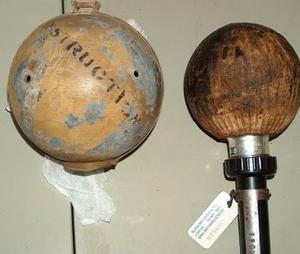Detecting sticky bombs
Sticky bombs — explosives affixed to a car, which explode when you turn the ignition key — as the stuff of movies dealing with the Mafia, but terrorists used them as well (as do the secret services of some countries); researchers at Argonne National Laboratory offer a way to detect surreptitiously placed sticky bombs

The sticky bomb, developed by the British during World War II as shown, is making a comeback in the Middle East // Source: blogspot.com
We have seen this scene in many movies, especially movies dealing with organized crime: someone enters his car, closes the door, turns the ignition key — and the car explodes, killing the driver. Security experts call the explosive device used to blow up cars a “sticky bomb.”
Mafia dons would be keenly interested in work being done on the topic at Argonne National Laboratory. A team of researchers — the Vulnerability Assessment Team (VAT) at Argonne — wanted to see whether it would be possible to detect surreptitiously placed sticky bombs. Roger G. Johnston, Jim Vetrone, and Jon S. Warner have just published an interesting paper on the issue in the Journal of Physical Security).
A sticky bomb is an explosive device, usually IED, which can be affixed to a vehicle either by magnetism or an adhesive. The diversity of these devices makes it difficult to create a single solution to detect them, which is why VAT considered a number of variables. The findings of their experiments can also apply to the theft of a vehicle’s contents, the unauthorized smuggling of cargo onto a vehicle, simple vehicle intrusion, or to detect a GPS by its electronic components.
The first half of the experiment depended on specific tire pressure measurements to detect any subtle changes in weight once the mock IED was placed either on the vehicle’s under carriage or exterior. The pressure was measured using a Vernier 12-bit analog-to-digital converter to sample a MKS Baratron differential pressure transducer (model 223BD-1ABB). Using these devices in conjunction, a tire differential of up to 19 millionths of a pound per square inch could be detected.
The tire pressure measurements were made on a stationary 2004 PT Cruiser and recorded on a simple laptop. The first trial involved the placement of a 10 pound weight beneath the driver’s floor. The readings were very distinct.
As the experiment continued, VAT realized that noise from a nearby construction site was disrupting their readings. The apparent vibrations in the tires made the detection of the 1 pound and 4 ounce weight more difficult.
The 1-pound weight trial yielded an interesting result as the chart indicated a downward trend. Possible explanations include a slow leak, temperature changes in the tire, and an incoming weather pressure front. The instruments were clearly very sensitive.
The detection of a 4-ounce weight was made, but similar readings would most likely be made in the event of rain or heavy wind. It was noted that effectively detecting such tire pressure fluctuations would be dramatically reduced in the event of a larger vehicle with multiple wheels.
It was hypothesized that tire pressure readings for a moving vehicle would most likely involve the implementation of pressure transducers within the tire, which is used in modern vehicles to notify the driver of low tire pressure.
The tire pressure portion of the experiment concluded with a demonstration of how someone entering a vehicle could be detected by the composite data of all four tire pressures. With this data, one could figure out which door the person had entered through and how long they spent inside the vehicle.
The second portion of the experiment involved magnetic measurements using two commercial DC measuring magnetometers. The more accurate of the two was recorded by the handheld Walker Scientific Triaxial FluxGate Magnetometer because it took all three axes into account as opposed to the PNI V2XE 2-axis Digital Compass.
VAT affixed a rare-earth magnet to different areas of a 1993 Subaru Legacy station wagon during their trials. The magnet had a holding strength of sixty pounds, which would most likely be excessive when considering sticky bombs, but was rationalized by VAT in the event that a terrorist “…wanted to be sure the sticky bomb remained on the vehicle as it traveled along bumpy roads.”
Based on the results, it was deduced that a magnet with 1/10th of the strength of the magnet used in the experiment would have easily been detected by the tri-axial magnetometer. More magnetometers would be necessary for a larger vehicle.
Although the researchers admit to time and pecuniary constraints, they believe further investigations are necessary for sticky bomb detection as well as the other security applications.
—Read more in Roger G. Johnston, Jim Vetrone, and Jon S. Warner, “Sticky Bomb Detection with Other Implications for Vehicle Security,” Journal of Physical Security 4, no. 1, Paper 5 (2010): 36-46
